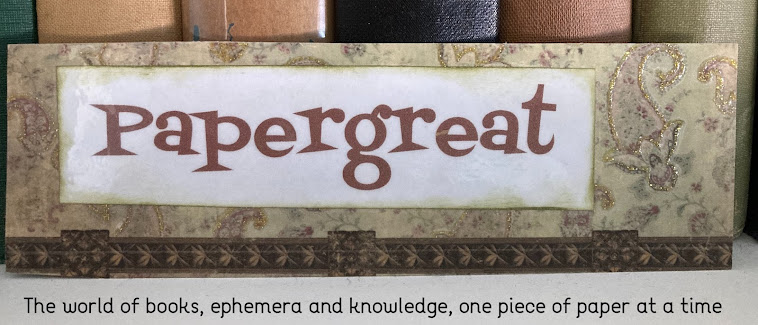Joan and I occasionally purchase large lots of used books. Some of them are from people who were selling books online and gave up. Some of them are from brick-and-mortar booksellers who were pruning inventory. Eventually, all of the books here in the Otto warehouse tend to blend together.
At some point along the way, we came into possession of a small portion of the former library of Elbert Nostrand Carvel (right)1, who served two terms as the governor of Delaware (January 1949-January 1953 and January 1961-January 1965).
The books offer some glimpses into Carvel's formative college days in the late 1920s and early 1930s and his political career, which took place during the early decades of the Cold War.
Carvel was a towering six-feet, six-inches tall and was nicknamed "Big Bert." According to his Wikipedia biography and a detailed obituary written by Celia Cohen in 2005, Carvel was a liberal Democrat in the vein of John F. Kennedy, Adlai Stevenson and Lyndon Johnson. Cohen writes:
"In the 1960s he opposed the death penalty and favored a public accommodations law, civil rights era legislation that opened public places like restaurants and hotels to all, including African-Americans. He paid for it politically and personally."Carvel also helped to create the Delaware Supreme Court in 1951 (it had been the last state without such a court) and oversaw the construction of the first span of the Delaware Memorial Bridge.
But before his two stints as governor and those civil-rights battles, Carvel was just another student, earning a law degree as a member of the Class of 1931 at the University of Baltimore. I have four of his law textbooks from this period. He had written his name on the first page of all of them and, in one instance, his address: 3106 Glenmore Avenue in Baltimore.2
The four Carvel textbooks I have are:
- "Handbook of Equity Jurisprudence" by James W. Eaton (1923 second edition by Archibald H. Throckmorton)
- "Handbook of the Law and Practice in Bankruptcy" by Henry Campbell Black (1930 second edition by editorial staff of the publisher)
- "Handbook of the Law of Municipal Corporations" by Roger W. Cooley (1914)
- "Handbook of the Conflict of Laws" by Herbert F. Goodrich (1927)
All of the books are part of the Hornbook Series published by West Publishing Co. of St. Paul, Minnesota.
But here's the coolest part: I found this sheet of paper tucked away inside one of Carvel's law textbooks...
It's a survey from the University of Baltimore's student yearbook, The Reporter. The 1931 Reporter wants to know "what the average Baltimorean likes."
Carvel signed his name at the top (which is the signature at the top of today's post) and provided the following answers:
- Do you adhere to a religion, are you agnostic, or are you atheistic? Adhere to a religion
- Favorite professor: Mr. Malloy
- Most valuable course: Contracts
- Favorite course: Conflict of Laws
- Favorite author: S.S. Van Dine
- Best book of the year: The Scarab Murder Case
- What age do you think proper for marriage? Twenty five (25)
- Best speaker: Frederick Storm
- Best all around man: Randolph
- Done the most for Baltimore: Arthur Price
- Done Baltimore the most: Meyerberg
- Best politician: Bryan
- Most popular: Smitty
- Most dignified: W.B. Brooks
- Highest undergraduate honor: Fred Storm
- Best natured: Ham Killen
- Most likely to succeed: Fred Storm
- Biggest Roué3: B. McCeney
- Would like to be: Tom Roche
- Has most drag with Profs: Dickerson
- Needs it most: Ziegler
- Handsomest: Chillie Clough
- Thinks she is4: Miss Winegar
- Best dressed: Tom Roche
- Our Favorite Telephone Number: Calvert 6060
- Is "She" blonde, brunette or red headed: Brunette
But here's a question: If I found this survey tucked away inside one of Carvel's textbooks, does that mean he never turned it in?
Sometime in the next few weeks I'll write Part 2 about the Carvel books and papers. We'll fast-forward 20 years, to his first term as Delaware's governor and a 1951 special session of the state senate to deal with matters relating to the Delaware Memorial Bridge. And then, from 1967, a look at Delaware's emergency procedures to deal with a nuclear attack on the United States.
Part 2: How would Delaware respond to a nuclear attack?
Footnotes
1. That image is from the State of Delaware's Hall of Governors online portrait gallery. When I finished writing this entry on July 17, Carvel's middle name was misspelled as "Nortrand" on that website.
2. According to Zillow, that address is now the site of a residential home in the Baltimore City School District that was built in 1975 and is currently valued at $148,300.
3. A Roué is a "debauched or lecherous person," although I wonder if The Reporter was using a more playful (and less damning) sense of the word.
4. The Reporter's original question was "Thinks he is." Carvel added an "s" in front of the "he" so that his answer could be about a woman. Hmmm.





No comments:
Post a Comment